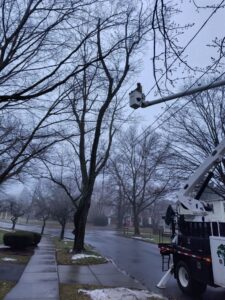As Central New York experiences an unseasonably warm February, many outdoor enthusiasts are itching to start their yard clean-up early. This opportunity to get a head start on spring chores is exciting, but it’s important to proceed with caution to ensure a vibrant garden and protect our essential pollinators. In this blog post, we will discuss the do’s and don’ts of early yard clean-up, with a particular focus on supporting the pollinators who are currently bedding down for winter.
**The Dos:**
- **Assess Your Garden:** Before diving into any clean-up tasks, take a stroll around your garden and assess the current state. Look for signs of emerging plants, active pollinators, and areas where the winter has taken its toll.
- **Clean Up Debris:** Remove any dead leaves, fallen branches, and other debris that have accumulated over the winter. This will help prevent pests and diseases from taking hold in your garden and allow for better air circulation around your plants.
- **Cut Back Perennials:** As temperatures rise, some perennials may start to show signs of growth. This is a great time to cut back any dead foliage to make way for new growth without damaging emerging shoots.
- **Prune Trees and Shrubs:** If your trees and shrubs require pruning, now is the time to address any dead or damaged branches. Avoid heavy pruning on spring-blooming plants, as you may unintentionally remove the buds that will provide beautiful blooms later in the season.
- **Prepare the Soil:** While the ground may still be cold, you can start preparing your soil for planting by adding compost or other organic matter. This will help improve soil structure and provide essential nutrients for your plants.
- **Support Pollinators:** Be mindful of the pollinators who are currently hibernating or bedding down for winter. Avoid disturbing areas where bees, butterflies, and other beneficial insects may be seeking refuge in your garden.
- **Create Pollinator-Friendly Habitats:** Consider planting early-blooming flowers like crocus, snowdrops, and witch hazel to provide food sources for pollinators as they emerge from hibernation. Adding native plants to your garden will also support local pollinator populations.
**The Don’ts:**
- **Avoid Heavy Foot Traffic:** While it may be tempting to get out into the garden and start working, avoid walking on wet or soggy soil. Compacting the soil can harm beneficial soil organisms and lead to poor drainage.
- **Delay Pruning Spring-Blooming Plants:** As mentioned earlier, refrain from heavy pruning on spring-blooming plants to avoid inadvertently removing the buds that will provide a burst of color later in the season.
- **Use Chemical Pesticides and Herbicides:** As you clean up your yard, opt for natural methods of pest control and weed management. Chemical pesticides and herbicides can harm pollinators and other beneficial insects, disrupting the delicate balance of your garden ecosystem.
- **Disturb Hibernating Pollinators:** Be cautious when cleaning up debris or turning over soil, as you may inadvertently disturb pollinators who are still hibernating. Many beneficial insects overwinter in leaf litter or hollow plant stems, so be mindful of their presence.
**Supporting Pollinators during Early Yard Clean-Up:**
As we navigate early yard clean-up in this unseasonably warm February, it’s crucial to remember the role of pollinators in our gardens. Pollinators such as bees, butterflies, and hummingbirds play a vital role in our ecosystem by facilitating plant reproduction. Supporting these essential creatures during their winter slumber is key to ensuring a successful garden come spring.
By following the do’s and don’ts outlined in this blog post, you can create a vibrant garden while also providing a safe




